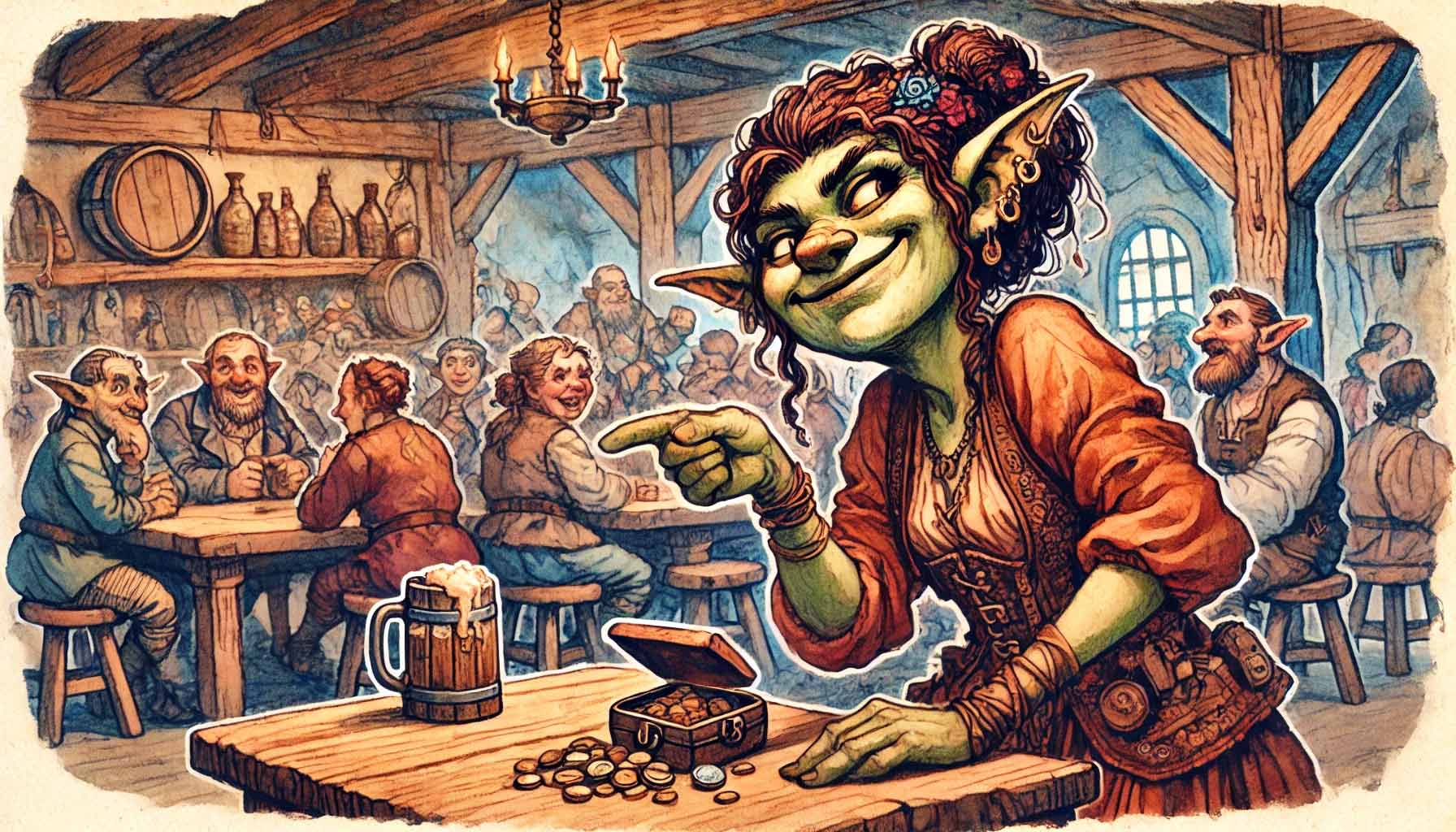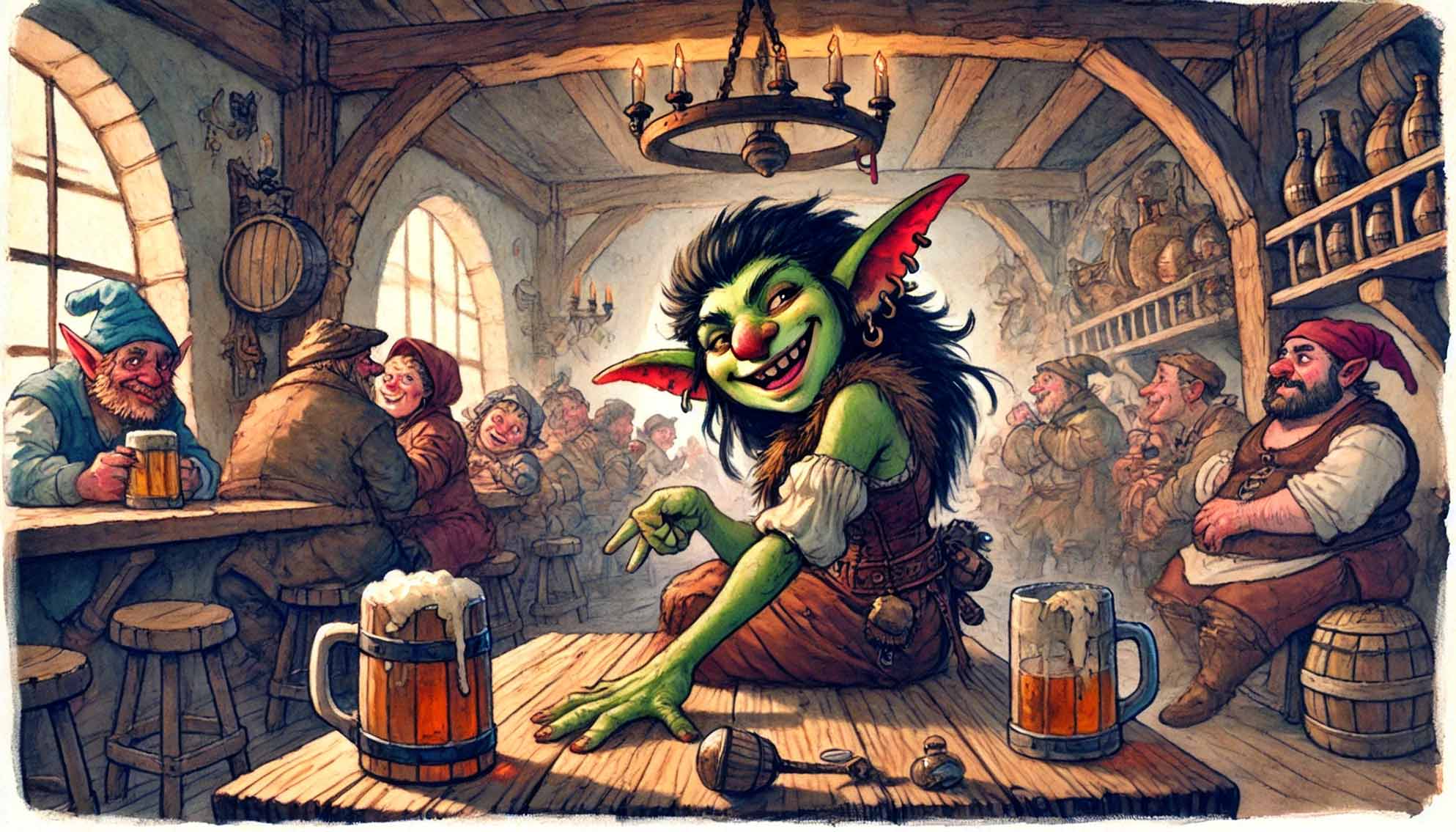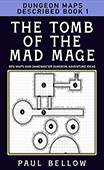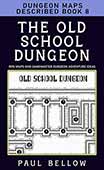Goblins. Those pesky, green troublemakers have been the bane of many adventurers’ existence since the dawn of Dungeons & Dragons. But what if we told you these pint-sized menaces could be the secret ingredient to spicing up your next gaming session? Forget about the serious, brooding villains for a moment. It’s time to embrace the chaos and hilarity that only a band of mischievous goblins can bring to the table.
Picture this: Your party of brave heroes, armed to the teeth and ready for epic battles, suddenly finds themselves face-to-face with a group of goblins more interested in pulling pranks than picking fights. The result? A symphony of groans, laughs, and unforgettable moments that will have your players talking for weeks.
Check out my *advanced* RPG AI Tools [GLOWING]
In this article, we’re diving headfirst into the wacky world of goblin shenanigans. We’ve cooked up 100 side-splitting scenarios that will turn even the most hardened adventurer into a giggling mess. Whether you’re a Dungeon Master looking to lighten the mood or a player hoping to suggest some goblin-themed tomfoolery, you’ve come to the right place.
So, grab your dice, leave your serious face at the door, and get ready to discover how these little green gremlins can become the comedic stars of your D&D campaign. Trust us, after this, you’ll never look at a goblin encounter the same way again.
Goblins: The Unsung Heroes of D&D Comedy
When most folks think of goblins in D&D, they picture sneaky attackers or cannon fodder for low-level adventurers. But these little green guys have so much more potential. They’re like the class clowns of the monster manual, just waiting for their moment to shine and bring down the house with laughter.
Goblins have a unique place in the D&D universe. They’re smart enough to form plans, but not quite bright enough to pull them off without a hitch. This combo makes them perfect for injecting some much-needed levity into even the most serious of quests. Imagine your party, tensed for battle, only to find a group of goblins engaged in a heated argument over who gets to wear the “lucky loincloth” into combat. It’s these unexpected moments that can turn a good gaming session into a great one.
But here’s the kicker – using goblins for comic relief doesn’t mean they can’t still be a challenge. In fact, their unpredictability can make them even more dangerous. Your players might be so busy laughing at the goblin trying to wield a sword twice its size that they don’t notice the other goblins setting up an actually clever ambush. It’s all about balance and keeping your players on their toes.
Timing is everything when it comes to goblin hijinks. A well-placed bit of goblin silliness can break tension, lighten the mood after a tough battle, or even distract from your hastily improvised plot point (we’ve all been there, fellow DMs). The key is to read the room and know when your players could use a good laugh.
100 Goblin Shenanigans to Keep Your Party Entertained
Get ready to unleash absolute mayhem on your unsuspecting players. We’ve brewed up a concoction of 100 goblin-tastic ideas that’ll have your gaming table in stitches. From the absurd to the cleverly stupid, these shenanigans are designed to catch your players off guard and leave them wondering, “Did that really just happen?”
Remember, the beauty of these goblin antics lies in their adaptability. Feel free to tweak, combine, or build upon these ideas to fit your campaign’s tone and your players’ sense of humor. After all, the best D&D moments often come from those unexpected twists that take everyone by surprise – players and DM alike.
So, without further ado, let’s dive into the wonderful world of goblin mischief. Brace yourselves for sneak attacks gone wrong, pranks that backfire spectacularly, and group activities that redefine the meaning of “organized chaos.”
Silly Sneak Attacks (1-20)
When it comes to ambushes, goblins have a… unique approach. Forget about careful planning and stealth. These little green troublemakers prefer a more, shall we say, creative method of catching their enemies off guard. Get ready for some sneak attacks that are more likely to induce laughter than fear.
Picture this: Your party is carefully making their way through a dense forest, senses alert for any sign of danger. Suddenly, they hear a commotion from the bushes ahead. Is it a fearsome beast? A group of bandits? Nope, it’s a bunch of goblins attempting to execute the world’s most ridiculous ambush. Here’s a taste of what your adventurers might encounter:
- The “Goblin Catapult”: One goblin attempts to launch another at the party using a makeshift seesaw. The flying goblin screams, “I instantly regret this decision!” mid-air.
- The “Trojan Rabbit”: Goblins poorly disguised as a giant rabbit hop awkwardly towards the party, giggling and shushing each other.
- “Goblin Tower of Terror”: A stack of goblins in a long coat pretends to be a tree, toppling over when a squirrel lands on top.
- “The Pit-fall”: Goblins dig a pitfall trap but forget which leaves are covering it. They spend the ambush trying not to fall in themselves.
- “Goblin Ghostbusters”: The goblins cover themselves in flour to look like ghosts, but start sneezing uncontrollably when the party approaches.
These are just a few examples of the mayhem that awaits. Each of these silly sneak attacks is designed to catch your players off guard and turn a potentially tense moment into comedy gold. The key is in the details – describe the goblins’ expressions of determination as their plans inevitably go awry, or the moment of panic when they realize they didn’t think things through.
Remember, while these attacks are meant to be funny, they can still pose a challenge to the party. Maybe the flying goblin accidentally knocks someone prone, or the pit trap, despite the goblins’ bumbling, actually catches an unsuspecting player. The beauty of these scenarios is that they keep your players guessing – they’ll never know if the next goblin encounter will be a genuine threat or a comedy of errors.
Chaotic Goblin Pranks (21-40)
Goblins aren’t just content with bungling their sneak attacks; they’ve got a real knack for pulling pranks too. These aren’t your run-of-the-mill practical jokes, though. Oh no, goblin pranks are a special breed of chaos, guaranteed to leave your party simultaneously amused and exasperated.
Imagine your adventurers setting up camp for the night, only to wake up and find their gear has been “improved” by some helpful goblins. Or picture the party’s tough-as-nails barbarian suddenly sporting a flower crown, courtesy of some sneaky green-skinned jesters. These pranks are designed to throw a wrench in the works, creating those delightful “What do we do now?” moments that make D&D so much fun.
Let’s dive into some of these goblin-grade pranks:
- “The Sticky Situation”: Goblins coat the party’s weapons with honey, attracting a swarm of bees.
- “Musical Mayhem”: The goblins replace all the coins in the party’s purse with copper pieces that play off-key musical notes when jiggled.
- “The Incredible Shrinking Armor”: Goblins sneak into camp and carefully adjust the straps on the fighter’s armor, making it comically tight.
- “Goblin Graffiti Artists”: The party wakes up to find their tents and gear covered in crude, colorful drawings of heroic goblins.
- “The Immovable Rod Switcheroo”: Goblins swap out a wizard’s wand for a stick painted to look like the wand. The real wand is hidden in plain sight, disguised as a twig.
These pranks aren’t just about getting a laugh (although that’s a big part of it). They’re also about creating interesting challenges for your players to overcome. How will the party deal with bee-attracted weapons? Can the wizard figure out which “stick” is their real wand before the next encounter?
The beauty of these goblin pranks is that they can be scaled to fit any situation. Maybe the honey-coated weapons come in handy when the party needs to climb a slippery surface. Or perhaps the musical coins end up being the key to solving a sound-based puzzle later in the adventure.
As a DM, you can use these pranks to inject some levity into tense situations, create unexpected obstacles, or even provide unorthodox solutions to problems. Just remember, the goal is to amuse and challenge your players, not frustrate them. Use these pranks wisely, and you’ll have your party alternating between groans and giggles in no time.

Goblin Group Activities (41-60)
When goblins get together, chaos is sure to follow. But there’s something oddly endearing about watching these little green menaces attempt to work as a team. Their group activities are less about efficiency and more about creating the kind of spectacle that leaves adventurers scratching their heads in bewilderment.
Picture a scene where your party stumbles upon a clearing full of goblins engaged in what can only be described as organized mayhem. It’s like watching a three-ring circus, but all the performers are small, green, and have a questionable grasp on the concept of teamwork. These group activities are perfect for those moments when you want to give your players a glimpse into the bizarre culture of goblinkind.
Let’s take a look at some of the wacky group antics your party might encounter:
- “The Great Goblin Bake Off”: A group of goblins furiously compete to create the most disgusting pie, using ingredients scavenged from the forest floor.
- “Goblin Olympics”: Goblins engage in ridiculous sports like “Stick Throwing,” “Mud Wrestling,” and “Who Can Scream the Loudest?”
- “The Goblin Pyramid Scheme”: A literal pyramid of goblins attempts to reach a beehive high in a tree, with predictably sticky results.
- “Goblin Theater Troupe”: A group performs a dramatically over-acted and poorly understood version of a human play they once saw.
- “The Great Goblin Debate”: Two groups of goblins argue passionately about whether the moon is made of cheese or giant eyeball, complete with poorly drawn diagrams.
These group activities serve multiple purposes in your game. First and foremost, they’re entertaining. There’s something inherently funny about watching creatures known for their chaotic nature try to organize themselves. It’s a perfect opportunity for some descriptive storytelling that will have your players grinning.
Secondly, these activities can provide insight into goblin society. Maybe your players learn that goblins value creativity and competition, even if their methods are unconventional. This could come in handy later if the party needs to negotiate with or infiltrate a goblin camp.
Lastly, these group antics can be used as a clever distraction. While the party is busy watching the goblin theater troupe’s bizarre interpretation of “Romeo and Juliet,” they might not notice the sneakier goblins picking their pockets or setting up an ambush.
As a DM, you can use these group activities to set the tone for goblin encounters in your campaign. Are your goblins bumbling comedic relief, or is there a method to their madness? The way you present these activities can shape how your players view and interact with goblins throughout your story.
Remember, the key to making these group activities work is in the details. Describe the determined looks on the goblins’ faces as they attempt their ridiculous tasks. Let your players hear the off-key singing of the goblin choir or smell the questionable ingredients of the goblin bake-off. The more vivid you make these scenes, the more memorable they’ll be for your players.
Mischievous Magic and Potions (61-80)
Hold onto your wizard hats, folks, because things are about to get wild. When goblins get their grubby little hands on magic and potions, the results are nothing short of spectacular – and by spectacular, we mean hilariously unpredictable. These aren’t your standard magic missiles or healing potions. Oh no, goblin magic is a whole different ball game.
Imagine a world where spells have a 50/50 chance of working as intended or turning the caster’s skin polka-dotted. Where potions might give you super strength, or they might just give you really bad gas. That’s the world of goblin magic, and it’s about to collide with your unsuspecting party.
Let’s dive into some of the magical mayhem your players might encounter:
- “The Wand of Wonder… ful Mistakes”: A goblin shaman waves a wand wildly, causing random effects like turning trees into jellybeans or making everyone speak in rhymes for an hour.
- “Potion of Giant Growth… Sort of”: A goblin drinks a potion and grows to the size of an ogre, but only from the waist up, leaving tiny legs struggling to support the massive torso.
- “The Teleportation Tango”: A group of goblins attempt to teleport but end up swapping body parts with each other instead.
- “The Invisible Ink Incident”: Goblins use a faulty invisibility potion that only turns their clothes invisible, leaving a group of very visible (and very embarrassed) goblins.
- “The Polymorph Potluck”: Goblins host a feast where every dish has a random polymorph effect. One minute you’re eating chicken, the next minute you are the chicken.
These magical mishaps serve multiple purposes in your game. First, they’re a goldmine for comic relief. There’s something inherently funny about magic gone wrong, especially when goblins are involved. It’s a great way to lighten the mood after a tense battle or to break up long stretches of serious roleplaying.
Secondly, these magical accidents can create interesting challenges for your players. How do they negotiate with a goblin who’s accidentally turned himself into a talking tree? What happens when the fighter’s sword is temporarily transformed into a rubber chicken? These situations force players to think creatively and use their problem-solving skills in unusual ways.
Lastly, goblin magic can be a great way to introduce wild card elements into your game. Maybe a misfired spell creates a portal to another plane, kicking off a whole new adventure. Or perhaps a botched potion gives a player character a temporary, but hilarious, new ability that comes in handy at just the right moment.
As a DM, you can use these magical mishaps to add an element of unpredictability to your game. They’re perfect for those moments when you want to throw your players a curveball or inject some chaos into an otherwise straightforward encounter.
Remember, the key to making goblin magic work is in the description. Don’t just tell your players that a spell went wrong – describe the look of surprise on the goblin’s face, the smell of burnt socks that fills the air, or the sound of a hundred rubber ducks suddenly appearing out of thin air. The more vivid and ridiculous you make these magical mishaps, the more your players will enjoy them.
Goblin-Inspired Improvisation (81-100)
Alright, buckle up, because we’re about to enter the realm of pure goblin chaos. When goblins are forced to think on their feet, the results are nothing short of comedic gold. These aren’t your average quick-thinking solutions – these are goblin-brained ideas that somehow manage to be brilliant and bonkers at the same time.
Picture a group of goblins faced with a problem they’ve never encountered before. Their solutions aren’t just outside the box; they’ve forgotten the box exists entirely. This is where goblin creativity truly shines, and where your players will find themselves both amused and oddly impressed by these little green problem-solvers.
Let’s dive into some of the improvised insanity your party might witness:
- “The Goblin Grappling Hook”: Unable to find a proper climbing tool, goblins attempt to scale a wall by throwing the stickiest goblin at it and forming a chain.
- “Diplomatic Disaster”: A goblin tries to negotiate with the party by offering increasingly ridiculous trades, like “this shiny rock for your magic sword” or “three perfectly good teeth for your wizard.”
- “The Living Bridge”: To cross a chasm, goblins form a wobbly, complaining bridge with their bodies, complete with tolls for crossing (“One sandwich per goblin, please!”). “Goblin Smoke Signals”: Attempting to communicate with distant allies, goblins create “smoke signals” by setting fire to various smelly objects, creating a noxious cloud that can be smelled for miles. “The Goblin Cannon”: In a desperate attempt to breach a fortress wall, goblins build a “cannon” out of a hollow log and use it to launch themselves over the wall, screaming battle cries (and regrets) as they fly.
These improvised solutions aren’t just for laughs – they can create unique challenges and opportunities for your players. How will they react when faced with a living goblin bridge? Will they pay the sandwich toll or find another way across? The beauty of these scenarios is that they encourage your players to think creatively too.
Let’s continue with more goblin-inspired madness:
- “The Goblin Disguise”: To infiltrate a human settlement, goblins stack up inside a large coat, creating a wobbling, suspiciously green “human” that speaks with multiple voices.
- “Goblin Fishing Expedition”: Out of traditional weapons, goblins attempt to catch adventurers using fishing rods baited with shiny objects and half-eaten sandwiches.
- “The Great Goblin Glider”: To escape pursuit, goblins hastily construct a “flying machine” out of leaves, twigs, and optimism, launching off a cliff with predictably chaotic results.
- “Goblin Fire Brigade”: Faced with a forest fire, goblins form a bucket chain, but instead of water, they pass increasingly random objects, from soup to live chickens, in a frantic attempt to douse the flames.
- “The Goblin Trojan Horse”: Unable to break into a storehouse, goblins build a crude “horse” out of barrels and scrap wood, then attempt to wheel it inside while making unconvincing horse noises.
These scenarios showcase the unique blend of creativity and chaos that defines goblin problem-solving. They’re not just amusing anecdotes; they’re opportunities for memorable gameplay moments. Imagine your players’ faces when they realize they’re being “fished” by goblins, or when they have to negotiate with a stack of goblins in a trench coat!
But wait, there’s more goblin-inspired lunacy to enjoy:
- “Goblin Postal Service”: To deliver a message quickly, goblins set up a chain of goblin “runners” who dramatically act out the message like a game of telephone gone wrong.
- “The Goblin Submarine”: To cross a river undetected, goblins submerge themselves in a large barrel, using reeds as breathing tubes and oars, creating a comically obvious “submarine.”
- “Goblin Siege Tactics”: Lacking proper siege weapons, goblins attempt to wear down defenders by staging increasingly bizarre and annoying performances outside the walls, from off-key serenades to dramatic readings of badly understood human literature.
- “The Goblin Talent Show”: When caught by the party, goblins attempt to win their freedom by staging an impromptu talent show, featuring such acts as “amazing” juggling (with only one ball) and “death-defying” acrobatics (somersaults).
- “Goblin Charades”: Unable to speak the common tongue, a goblin scout attempts to report vital information through an elaborate, frustrating game of charades.
These improvisations highlight the unpredictable nature of goblin encounters. They transform what could be straightforward combat situations into opportunities for roleplay, problem-solving, and unexpected alliances. Your players might find themselves so amused by the goblin talent show that they decide to negotiate rather than fight!
Let’s wrap up with the final set of goblin-inspired improvisations:
- “The Goblin Hot Air Balloon”: To gain a aerial advantage, goblins inflate a giant sheep’s bladder with hot air, creating a wildly unstable flying machine piloted by the most expendable goblin.
- “Goblin Archaeology”: Mistaking a simple campsite for an ancient ruin, goblins conduct a hilariously inaccurate “archaeological dig,” coming to outlandish conclusions about “ancient human civilization” based on mundane items.
- “The Goblin Spa Day”: Stumbling upon a hot spring, goblins set up an impromptu “luxury spa,” offering adventurers dubious beauty treatments and massages in exchange for shiny trinkets.
- “Goblin Recycling Program”: In an attempt to “go green,” goblins start a recycling initiative, enthusiastically collecting and repurposing adventurers’ discarded items into increasingly useless and bizarre “inventions.”
- “The Ultimate Goblin Weapon”: Combining all their knowledge of “advanced human weaponry,” goblins create a comically impractical super-weapon that’s more dangerous to its users than any intended target.
These final examples of goblin improvisation showcase the full spectrum of goblin ingenuity (or lack thereof). They’re not just random silly events; they’re opportunities for your players to interact with the world in unexpected ways. Maybe the party’s barbarian discovers a hidden talent for spa treatments, or the wizard becomes oddly invested in correcting the goblins’ archaeological misconceptions.
As a DM, these scenarios give you tools to create memorable, laugh-out-loud moments that your players will be talking about long after the session ends. They also provide opportunities to flesh out your world’s goblin culture, showing them as more than just generic monsters to be defeated.
Remember, the key to making these improvisations work is in the delivery. Describe the goblins’ enthusiasm, their proud explanations of clearly flawed logic, and their unwavering commitment to their ridiculous ideas. Let your players see the thought process (however misguided) behind these goblin schemes.
Ultimately, these goblin-inspired improvisations serve to make your world feel more alive, more unpredictable, and most importantly, more fun. They turn ordinary encounters into extraordinary stories, and isn’t that what D&D is all about?
Wrapping Up the Goblin Madness
We’ve journeyed through 100 goblin shenanigans, from silly sneak attacks to improvised insanity. By now, you should have a treasure trove of ideas to unleash goblin chaos in your D&D games. But remember, these aren’t just random events – they’re tools to create memorable moments, challenge your players in unexpected ways, and bring your game world to life.
Goblins, with all their chaotic energy and misguided creativity, offer a unique opportunity to balance humor with challenge in your D&D sessions. They can provide comic relief after intense moments, create unusual obstacles for your players to overcome, and even become unlikely allies (or at least amusing adversaries) in your campaign.
As you incorporate these ideas into your game, keep these tips in mind:
- Read your table: Not every group will appreciate the same level of goblin-induced chaos. Tailor the shenanigans to fit your players’ sense of humor and play style.
- Balance is key: While these antics are fun, don’t let them overshadow the main plot or more serious elements of your campaign. Use goblin shenanigans to enhance the story, not derail it.
- Encourage creativity: These scenarios often require out-of-the-box thinking. Reward players who come up with clever solutions to goblin-created problems.
- Build on the ideas: Use these shenanigans as a starting point. Combine them, expand on them, and let them inspire your own unique goblin encounters.
- Develop goblin culture: These antics can help you flesh out the goblins in your world. Are they seen as annoying pests, or is there method to their madness that earns them a odd sort of respect?
Remember, at the end of the day, D&D is about having fun and creating stories together. These goblin shenanigans are just one more tool in your DM toolkit to help make your games memorable, engaging, and downright hilarious.
So go forth, unleash the goblin madness, and may your dice rolls be ever in your favor (unless you’re rolling for goblin plans to succeed – in which case, may they fail spectacularly and hilariously)!
Check out my *advanced* RPG AI Tools [GLOWING]







